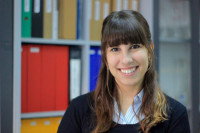Pollution
Marine Biodiversity
Pandemics & Infectious Diseases
Plastics
Antimicrobials, Antibiotics & Drug Resistances
Bacteria & Other Microorganisms
Water Quality
Post-Doctoral Fellowships
Italy
2019.08.31
Microplastics: their role in the spread of antibiotic resistance
Antibiotic resistance (AR) is considered by the World Health Organization (WHO) as one of the biggest threats to global health, food security and development today. It occurs when, as a result of their exposure to antibiotics, bacteria progressively develop the ability to combat their action. Although this is a naturally-occurring phenomenon, the misuse and/or overuse of antibiotics have dramatically accelerated the process, imperiling the incommensurable progress achieved in the fight against infectious diseases globally since the invention of penicillin in the early 20th century. To limit the propagation of this scourge, WHO recommends intensive monitoring for the identification and surveillance of critical hot spots. Point sources of pollution, such as wastewater treatment plants or agricultural facilities, are suspected of playing a major role in the dissemination of antibiotic-resistant bacteria and genes in the natural environment. Concomitantly, as Dr. Maria Belen Sathicq points out, such pollution sources also release microplastics. A researcher in microbial ecology at the Water Research Institute in Italy, Dr. Sathicq aims to explore the magnitude of the release of AR from these point sources of pollution, as well as the role microplastic particles play in the dissemination. Indeed, recent studies have pointed the finger at these particles for their potential role as substrate and carrier of the spread of determinants of AR in water. The overall objective of this project, called AENEAS (as a reference to the Greek mythological hero who crossed the seas and founded Rome) is to contribute to a better, more comprehensive, understanding of the drivers behind the spread of antibiotic resistance.
Bacteria spread via many routes. They can either spontaneously develop in a human or an animal following antibiotic intake, spread from one carrier to another (whether animal or human), through food, or via the environment (soil, air, and water). “My research looks at the presence and survival of antibiotic-resistant bacteria in coastal waters, following contamination by effluents of urban wastewater treatment plants or by the outflow of canals draining agricultural land into the sea", explains Dr. Sathicq. Her investigation builds notably on the already established correlation between the abnormal presence of AR determinants in coastal waters and abnormal levels of AR in humans: “a study from 2018 found that people who spent a lot of time in polluted coastal waters were more likely to carry antibiotic-resistant bacteria in their microbiome”, she reported. “In normal conditions, bacteria are not supposed to survive for very long in coastal waters, but the presence of microplastics changes things. They can attach to the plastic and form a biofilm on the surface. It creates a more welcoming environment for them, raising their chances of survival. They can live longer, travel further away, and even reproduce. What is more, within these biofilms, proximity between the bacteria enables the exchange of DNA, including antibiotic-resistant genes. This process is called horizontal gene transfer. This means that, in these environments, extracellular DNA (free DNA) carrying antibiotic-resistant genes is potentially present, representing a high risk of contagion for non-resistant bacteria”.
A multi-disciplinary approach: assessing both the problem and society’s perception of it
To test the hypothesis that microplastic particles favor the diffusion and establishment of AR within marine environments, Dr. Sathicq’s project will conduct two consecutive work packages: assessing the presence of microplastics in coastal waters, the impact of point pollution sources, and the microbial diversity and composition of the microbial communities in open waters and microplastics, and study the mechanisms underlying the spread of antibiotic resistance and the potential role played by microplastics in their promotion. Specifically, the researcher and her team will collect samples from 9 different locations along the Tyrrhenian coast (Italy), assess the amount and types of microplastics present, the number of bacteria on the plastics and in the water, and use genomics to identify and classify them. In controlled laboratory conditions, they will then test the exact mechanisms underlying the role of microplastics, with a focus on horizontal gene transfer.
The project will not limit itself to studying the role of microplastic particles but will also assess society’s awareness and perception of the risk they pose. Precisely, Dr. Sathicq aims to analyze and assess the level of awareness among stakeholders (professional fishermen, administrators and citizens living along the coast) of the importance of marine microbial biodiversity, as well as of the risk that the presence of microplastics and AR represent. Her team will even work hand in hand with local people, engaging in the booming trend of citizen science. “People who live in these areas know things we don’t; they’ve lived there for years. It would be a shame not to put this knowledge to good use!”.
By bridging the fields of functional ecology and disease ecology in this way, the present AXA-funded post-doctoral project subscribes to a worldwide research initiative called ‘OneHealth’, a collaborative and multidisciplinary effort to solving global and environmental health challenges. The project’s multidisciplinary approach, coupling biology, ecology and genomics with social science and statistics, will enable a remarkably comprehensive take on the highly-relevant subject of the impact of microplastic in the spread of antibiotic resistance in water. In this sense, the project’s findings are expected to make a valuable contribution to the design of efficient mitigation strategies.

Maria Belén
SATHICQ
Institution
Consiglio Nazionale delle Ricerche
Istituto di Ricerca sulle Acque (IRSA)
Country
Italy
Nationality
Argentinian
Related articles
Climate Change
Pollution
Aerosols & Particulate Matters
Public Health & Health Policy
Toxic Pollutants & Hazardous Substances
Post-Doctoral Fellowship
Greece
2023.06.01
Insight in Dust Fine-Mode to Mitigate Health Hazards in a Changing Climate
Expected start date:June-2023 In late-April/early-May 2022, a surge of remarkable dust storms ravaged Iraq, resulted- according to the World Health... Read more

Emmanouil
PROESTAKIS
.thumbnail.jpg)
